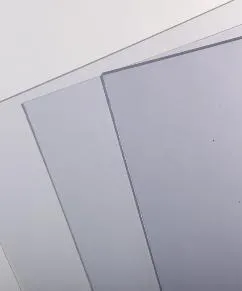Jun . 06, 2025 14:34 Ad album
PVC Sheet: A Versatile Material for Modern Construction and Design
In the ever-evolving world of construction and interior design, materials that are durable, cost-effective, and easy to work with are always in high demand. Among these, the PVC sheet stands out as a top choice for both commercial and residential projects. Whether it's for wall cladding, signage, furniture, or industrial use, PVC plastic sheet products offer outstanding performance and design flexibility.
This article will explore the many advantages of PVC materials, especially focusing on the benefits of using PVC sheet for wall applications, while helping buyers and installers understand what to look for when choosing this multifunctional material.

What Is a PVC Sheet?
A PVC sheet is a flat panel made from polyvinyl chloride (PVC), a synthetic plastic polymer known for its strength, versatility, and resistance to moisture and chemicals. These sheets come in various thicknesses, sizes, colors, and surface finishes, making them suitable for a wide range of applications.
PVC sheets are manufactured through extrusion, creating uniform panels that are easy to cut, shape, and install. From small-scale DIY projects to full-scale commercial interiors, this material has proven to be reliable, stylish, and durable.
Why Choose PVC Plastic Sheet Over Other Materials?
The PVC plastic sheet has become increasingly popular in industries ranging from construction to advertising, and for good reason:
Durability: PVC sheets are highly resistant to impact, moisture, chemicals, and fire. This makes them ideal for use in wet or humid environments, such as kitchens, bathrooms, and industrial facilities.
Lightweight: Compared to materials like wood, glass, or metal, PVC plastic sheets are much lighter, making them easier to transport and install without the need for heavy-duty equipment.
Cost-Effective: PVC is a budget-friendly material that offers excellent value for money. It reduces maintenance costs over time thanks to its resistance to wear and environmental damage.
Low Maintenance: A simple wipe with water and mild detergent is enough to keep the surface clean and hygienic.
Non-Porous and Hygienic: This makes it an ideal surface for food processing areas, hospitals, or places where hygiene is critical.
PVC Sheet for Wall Applications
When it comes to interior or exterior wall applications, the PVC sheet for wall stands out for its aesthetic appeal and practical advantages. Unlike traditional wall materials like tiles, wood panels, or paint, PVC wall sheets are easy to install, long-lasting, and visually appealing.
Key Benefits:
Moisture Resistance: Ideal for bathrooms, kitchens, and basements, where water exposure is common.
Easy Installation: Most sheets come with interlocking edges or can be applied using adhesives, making installation fast and convenient.
Stylish Designs: Available in a variety of textures, patterns, and colors—from matte white to glossy wood finishes—PVC sheet for wall options suit a broad range of décor styles.
Insulation: PVC offers decent thermal and sound insulation, contributing to energy efficiency and noise reduction.
Fire Retardant: Many PVC wall panels meet fire safety standards, making them safe for residential and commercial buildings.
Whether renovating a home or designing a new retail store, PVC sheet for wall panels provide a clean, modern look with minimal hassle.
Common Uses of PVC Plastic Sheet
The versatility of PVC plastic sheet materials extends far beyond wall cladding. Here are some common uses:
Signage and Display Boards: Lightweight and easy to print on, making them ideal for advertising and promotional materials.
Furniture and Cabinetry: Used as an overlay for tables, cabinets, and countertops.
Partitions and Ceilings: Easy to clean and maintain, suitable for healthcare facilities or commercial spaces.
Construction: Used in roofing, false ceilings, and temporary walls.
Industrial Applications: Suitable for chemical-resistant lining, electrical insulation, and protective barriers.
Installation Tips for PVC Sheet for Wall
Installing a PVC sheet for wall is generally simple, but following best practices ensures a long-lasting result:
Prepare the Surface: Ensure the wall is dry, flat, and clean.
Cut to Size: Use a utility knife or circular saw to cut sheets to the desired dimensions.
Apply Adhesive or Fasteners: Use recommended adhesives or mounting clips for secure placement.
Seal Joints: For wet areas, use silicone sealant to prevent water infiltration between panels.
Allow for Expansion: Leave small gaps at the edges to accommodate expansion and contraction due to temperature changes.
PVC Sheet FAQs
Q1: Is PVC sheet waterproof?
A: Yes, PVC sheets are completely waterproof, making them suitable for bathrooms, kitchens, and outdoor use.
Q2: Can I paint a PVC plastic sheet?
A: While PVC sheets come pre-finished, some can be painted using specialized primers and plastic-compatible paints.
Q3: Are PVC sheets environmentally friendly?
A: PVC is recyclable, but it's important to dispose of or recycle it properly. Many manufacturers offer eco-friendly PVC options.
Q4: How long does PVC wall cladding last?
A: With proper care, PVC sheet for wall applications can last over 10–15 years without fading or cracking.
Q5: Is a PVC plastic sheet suitable for outdoor use?
A: Yes, but make sure it’s UV stabilized to prevent degradation from sunlight exposure.
Whether you're a homeowner looking for stylish, low-maintenance wall coverings or a contractor seeking reliable building materials, the PVC sheet is a practical and versatile choice. With its combination of strength, affordability, and ease of use, the PVC plastic sheet has become a go-to material for a variety of design and construction needs.
Especially in wall applications, the PVC sheet for wall offers a modern alternative to traditional materials, bringing efficiency and aesthetic appeal into perfect balance. Choose quality PVC sheets from trusted suppliers and enjoy the benefits of this all-purpose solution.
-
Comprehensive Guide To HDPE Pipes and Fittings | Durable & Sustainable Solutions
NewsNov.24,2025
-
HDPE Culvert Pipe – Durable, Flexible & Sustainable Infrastructure Solutions
NewsNov.24,2025
-
DWC HDPE Pipe – Durable, Cost-Effective Drainage and Conduit Solutions
NewsNov.23,2025
-
HDPE Drainage Pipe – Durable and Sustainable Water Management Solutions
NewsNov.23,2025
-
Durable and Sustainable HDPE Corrugated Pipe Solutions for Modern Infrastructure
NewsNov.23,2025
-
HDPE Water Pipe - Durable, Cost-Effective Water Solutions for Global Needs
NewsNov.22,2025

